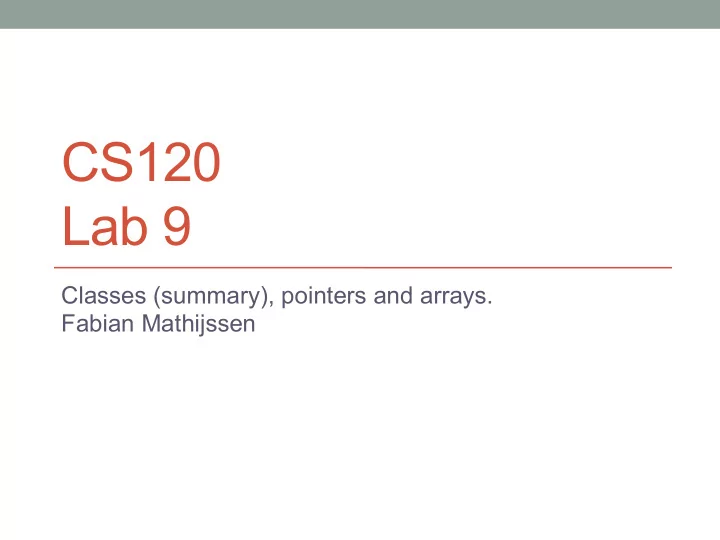

CS120 Lab 9 Classes (summary), pointers and arrays. Fabian Mathijssen
Classes (summary) • A class is: • Class definition (header file or inline) Remember: include header files with <> or “” • Source code file • Classes may model anything in real life. • Classes are blueprints! • Usually useless by themselves • Good for making objects -> have objects do stuff
Pointers (1/4) • Pointers are memory addresses, so numbers. • Written as *, pronounced “pointer” or “star”. • Pointers have types! è Primitive types: int* , float* , char* , etc. è Object types: Chair* , Monitor* , Book* , etc. • The size of a pointer depends on the operating system you’re using. In a nutshell, 64-bit computers have 64-bit memory addresses, so pointers are 8 bytes large. Tip: use sizeof(variableName) to check size of a variable!
Pointers (2/4) • Create pointer: int *i; The pointer i doesn’t point to anything right now, so in other words, the memory address i points to doesn’t contain a value. • Dereference pointer: *i = 28; Now the memory address i points to contains value 28. • Get a variable’s address: int k = 26; i = &k; Now the pointer i points to the address of k , which means i points to an address that contains value 26. • & is pronounced as “address of”.
Pointers (3/4) You can create a pointer to a pointer! int **k; //a reference to a memory location that holds a //reference to a memory location that holds an //integer value! **k = 17; int m = **k; //Deferences the pointer to k and dereferences //the pointer to the dereferenced value. //Puts the dereferenced value into m.
Pointers (4/4) As you may see, one can certainly overuse pointers! int **********m; **********m = 128;
Arrays (1/4) • An array is a sequence of elements. • An array has a number of positions that cannot be changed when set. Ex.: char name[6] = {‘F’, ‘a’, ‘b’, ‘i’, ‘a’, ‘n’}; ‘F’ ‘a’ ‘b’ ‘i' ‘a’ ‘n’ • An array is really a pointer to the first element in a sequence of elements! We’ll overlook this for now. J
Arrays (2/4) • Get the element at position i from the array like so: int longnumber[6] = {9, 7, 3, 4, 5, 1}; int secondDigit = longNumber[1]; // = 7 Note: an array with n positions has positions numbered 0 through n -1.
Arrays (3/4) • Go through an array with for loops to get each individual element: int longnumber[6] = {9, 7, 3, 4, 5, 1}; for (int i=0; i<6; i++) { cout << longNumber[i]; } • Note: store the length of the array in a variable so you know how many iterations the for loop must have!
Arrays (4/4) • You can have an array of arrays, a.k.a. a 2-dimensional array. • Note: Each position is a pointer to the first element of another array. • Make a 2-D array with x by y positions like this: int twoDArray[y][x]; • Retrieve an element from this array at position 3 by 5 like so: int retrievedElement = twoDArray[3][5];
Last note on arrays... • Trick question: how do you get the size (nr of positions) of an array? • How do you get the size of a 2-D array? • Hint: use sizeof()!
Retrospective • How hard do the week 1-3 labs seem now? ;-)
Recommend
More recommend